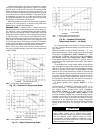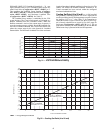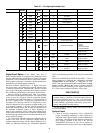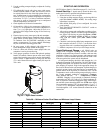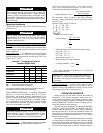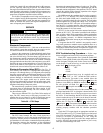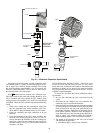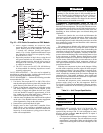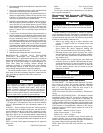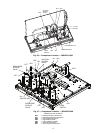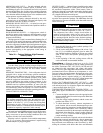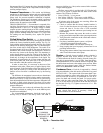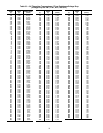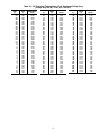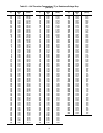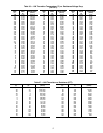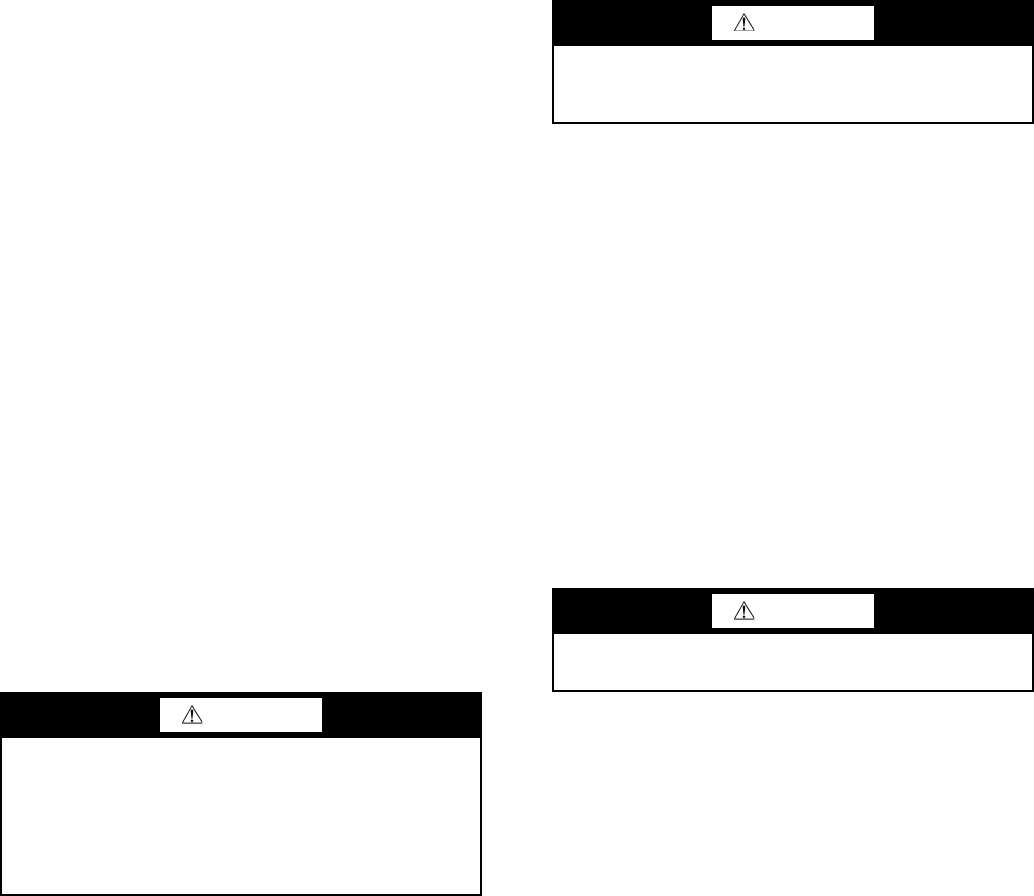
50
2. Disconnect the liquid-in and liquid-out connections at the
heat exchanger.
3. Recover the refrigerant from the system, and unsolder the
refrigerant-in and refrigerant-out connections.
4. Remove the old heat exchanger. The replacement heat ex-
changer is supplied fully insulated. It also includes a cool-
er heater. Use of the heater is not required unless the orig-
inal cooler contained a factory installed heater.
5. Install the replacement heat exchanger in the unit and at-
tach the mounting bracket hardware to the fan uprights
(sizes 010-030) or to the bottom bracket (sizes 035-060)
using the hardware removed in Step 4. Reconnect the
cooler heater if required. For sizes 010-025, torque the
bolts to 7-10 ft-lb. For sizes 030-060, torque the bolts to
30-50 ft-lb.
6. Carefully braze the refrigerant lines to the connections on
the heat exchanger. Lines should be soldered using silver
as the soldering material with a minimum of 45% silver.
Keep the temperature below 1472 F (800 C) under nor-
mal soldering conditions (no vacuum) to prevent the cop-
per solder of the brazed plate heat exchanger from chang-
ing its structure. Failure to do so can result in internal
or external leakage at the connections which cannot be re-
paired. Braze the liquid lines with a heat sink around the
expansion valve to protect it from excess heat.
7. Reconnect the water/brine lines.
8. Dehydrate and recharge the unit. Check for leaks.
BRAZED-PLATE COOLER HEAT EXCHANGER
CLEANING — Brazed-plate heat exchangers must be
cleaned chemically. A professional cleaning service skilled in
chemical cleaning should be used. Use a weak acid (5% phos-
phoric acid, or if the heat exchanger is cleaned frequently, 5%
oxalic acid). Pump the cleaning solution through the
exchanger, preferably in a backflush mode. After cleaning,
rinse with large amounts of fresh water to dispose of all the
acid. Cleaning materials must be disposed of properly.
The factory-installed strainer screen in front of the water/
brine inlets of the heat exchangers should be cleaned periodi-
cally, depending on condition of the chiller water/brine.
Oil Charge
Puron refrigerant systems use a polyol ester (POE) oil. Use
only Carrier approved compressor oil. Oil should be visible in
compressor oil sight glass. An acceptable oil level is from
1
/
8
to
3
/
8
of sight glass. All compressors must be off when checking
oil level. Recommended oil level adjustment method is as
follows:
ADD OIL — Recover charge from the unit. Add oil to suction
line Schrader valve on tandem compressors sets and the com-
pressor Schrader on the trio's and single compressor circuits.
(See Fig. 26 and 27.) When oil can be seen at the bottom of the
sight glass, add oil in 5 oz increments which is approximately
1
/
8
in oil level. Run all compressors for 20 minutes then shut off
to check oil level. Repeat procedure until acceptable oil level is
present.
NOTE: Use only Carrier approved compressor oil. Approved
sources are:
Totaline . . . . . . . . . . . . . . . . . . . . . . 3MAF POE, P903-1601
Mobil . . . . . . . . . . . . . . . . . . . . . . . . . . .EAL Arctic 32-3MA
Uniqema . . . . . . . . . . . . . . . . . . . . . . . . . . . . . . RL32-3MAF
Do not reuse oil that has been drained out, or oil that has
been exposed to atmosphere.
Microchannel Heat Exchanger (MCHX) Con-
denser Coil Maintenance and Cleaning
Recommendations
Routine cleaning of coil surfaces is essential to maintain
proper operation of the unit. Elimination of contamination and
removal of harmful residues will greatly increase the life of the
coil and extend the life of the unit. The following steps should
be taken to clean MCHX condenser coils:
1. Remove any foreign objects or debris attached to the
coreface or trapped within the mounting frame and
brackets.
2. Put on personal protective equipment including safety-
glasses and/or face shield, waterproof clothing and
gloves. It is recommended to use full coverage clothing.
3. Start high pressure water sprayer and purge any soap or
industrial cleaners from sprayer before cleaning condens-
er coils. Only clean, potable water is authorized for clean-
ing condenser coils.
4. Clean condenser face by spraying the core steady and
uniformly from top to bottom while directing the spray
straight toward the core. Do not exceed 900 psig or 30 de-
gree angle. The nozzle must be at least 12 in. from the
core face. Reduce pressure and use caution to prevent
damage to air centers.
Check Refrigerant Feed Components
FILTER DRIER — The function of the filter drier is to main-
tain a clean, dry system. The moisture indicator (described
below) indicates any need to change the filter drier. The filter
drier is a sealed-type drier. When the drier needs to be
changed, the entire filter drier must be replaced.
NOTE: Dual circuit (035-060 sizes) units have 1 filter drier per
circuit.
MOISTURE-LIQUID INDICATOR — The indicator is located
immediately ahead of the TXV to provide an indication of the
refrigerant moisture content. It also provides a sight glass for
refrigerant liquid. Clear flow of liquid refrigerant (at full unit
loading) indicates sufficient charge in the system. Bubbles in the
sight glass (at full unit loading) indicate an undercharged system
or the presence of noncondensables. Moisture in the system,
measured in parts per million (ppm), changes the color of the
indicator as follows:
Green (safe) —Moisture is below 75 ppm
Yellow-Green (caution) — 75 to 150 ppm
Yellow (wet) — above 150 ppm
The unit must be in operation at least 12 hours before the
moisture indicator gives an accurate reading, and must be in
contact with liquid refrigerant. At the first sign of moisture in
the system, change the corresponding filter drier.
NOTE: Dual circuit (035-060 sizes) units have one indicator
per circuit.
CAUTION
The compressor in a Puron
®
refigerant (R-410A) system
uses a polyol ester (POE) oil. This is extremely hygro-
scopic, meaning it absorbs water readily. POE oils can
absorb 15 times as much water as other oils designed for
HCFC and CFC refrigerants. Take all necessary precau-
tions to avoid exposure of the oil to the atmosphere. Failure
to do so could result in possible equipment damage.
CAUTION
Do not apply any chemical cleaners to MCHX condenser
coils. These cleaners can accelerate corrosion and damage
the coil.
CAUTION
Excessive water pressure will fracture the braze between
air centers and refrigerant tubes.



